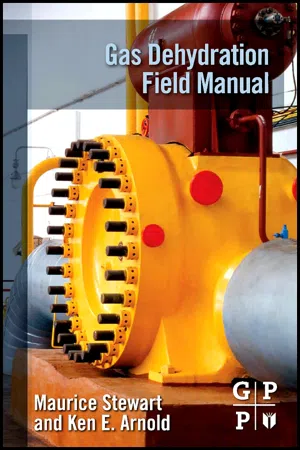
- 260 pages
- English
- ePUB (mobile friendly)
- Available on iOS & Android
Gas Dehydration Field Manual
About this book
Gas Dehydration Field Manual presents different methods of gas dehydration, focusing on the differences between adsorption and absorption. It discusses the various designs and operations in a gas processing facility. As an introduction, the book provides different concepts and theories that describe the gas processing industry. It then discusses the processes involved in the gas processing industry, which include absorption, adsorption, glycol regeneration, glycol filtration, and carbon purification. The book is divided into three parts. The first part discusses some of the basic terms and concepts of gas dehydration. The second part focuses on the factors involved in the different gas-dehydration methods. It also describes the difference between absorption and adsorption, as well as the process involved in glycol dehydration. The last part of the book discusses the proper care, maintenance, and troubleshooting methods of glycol dehydration process. This book is mainly designed for engineers, technologists, and operating personnel in the gas processing industry. Aside from engineers and process designers, readers who are interested in the different processes involved in gas dehydration will find this book a useful guide and reference.- Include hydrate prevention, chemical injection systems, hydrate inhibitor methods- Condensation process, Glycol Regeneration and Molecular Sieves- An appendix provides the reader with additional exercises and solutions
Frequently asked questions
- Essential is ideal for learners and professionals who enjoy exploring a wide range of subjects. Access the Essential Library with 800,000+ trusted titles and best-sellers across business, personal growth, and the humanities. Includes unlimited reading time and Standard Read Aloud voice.
- Complete: Perfect for advanced learners and researchers needing full, unrestricted access. Unlock 1.4M+ books across hundreds of subjects, including academic and specialized titles. The Complete Plan also includes advanced features like Premium Read Aloud and Research Assistant.
Please note we cannot support devices running on iOS 13 and Android 7 or earlier. Learn more about using the app.
Information
Contents
Objectives
Overview
Dew Point
Dew Point Depression
Why Dehydrate?
Table of contents
- Cover image
- Table of Contents
- Front matter
- Copyright
- Part 1. Hydrate Prediction and Prevention
- Part 2. Dehydration Considerations
- Part 3. Glycol Maintenance, Care, and Troubleshooting
- References
- Index